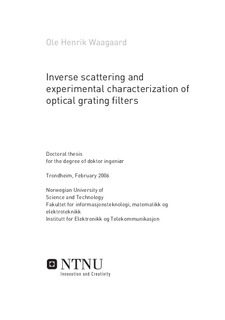| dc.contributor.author | Waagaard, Ole Henrik | nb_NO |
| dc.date.accessioned | 2014-12-19T13:42:31Z | |
| dc.date.accessioned | 2015-12-22T11:39:42Z | |
| dc.date.available | 2014-12-19T13:42:31Z | |
| dc.date.available | 2015-12-22T11:39:42Z | |
| dc.date.created | 2007-07-20 | nb_NO |
| dc.date.issued | 2007 | nb_NO |
| dc.identifier | 122473 | nb_NO |
| dc.identifier.isbn | 82-471-7817-6 | nb_NO |
| dc.identifier.uri | http://hdl.handle.net/11250/2368793 | |
| dc.description.abstract | This thesis mainly studies inverse scattering applied to the field of fiber Bragg gratings. I focus on the layer-peeling inverse scattering algorithm, and use this algorithm to design gratings and reconstruct their spatial profile from measured complex reflection spectra.
Using a discrete grating model, we find necessary and sufficient conditions for the reflection response to be realizable as a grating of finite length. With the help of these conditions, a general method for designing gratings with a given finite length is proposed. The proposed method is demonstrated to give designs with better side lobe suppression and less ripple than designs based on windowing.
Fiber Bragg gratings is known to be birefringent with slightly polarizationdependent background index and polarization-dependent effective index contrast. The birefringence may lead to coupling between polarization modes. Scattering will now involve two forward-propagating and two backward-propagating modes, and the response from the grating is characterized by a frequency-dependent reflection Jones matrix. A polarization-resolved layer-peeling algorithm is developed to reconstruct the polarization-dependent background index and polarization-dependent effective index contrast from the reflection Jones matrix. Realizability criteria for birefringent gratings of a finite length is obtained.
In some cases, more than two waveguide modes interact. There may be interaction between bounded modes within a fiber supporting several modes, or between the core mode and cladding modes in a “single mode” fiber. To handle inverse scattering in such cases, we have developed a layer-peeling algorithm that takes into account any number of interacting modes, where the interaction may be both codirectional and contradirectional. The modes may have equal or different propagation constants. We will show that this method can also be used for discrete multimode structures and 3D structures.
The complex reflectivity spectrum of gratings is measured with optical frequency domain reflectometry. The response from a Michelson interferometer, where the grating constitutes one of the reflectors, is recorded while sweeping the laser. The measured spectrum is fed into the layer-peeling algorithm for calculation of the spatial profile of the grating. The method gives satisfactory results for gratings up to 98-99 %. In order to spatially characterize stronger gratings, the grating is thermally chirped so that the reflectivity is reduced and the spectral information is spread over a wider bandwidth. In this way, the spatial profile of a grating with −66 dB minimum transmission is successfully reconstructed.
A method for measuring the reflection Jones matrix of gratings has been developed. The source polarization is continuously modulated through four states of polarization that can be represented by four linearly independent Stokes vectors. This polarization modulation is achieved by placing a Mach-Zehnder-type interferometer in between the laser and the Michelson interferometer containing the grating.
The polarization modulation interferometer has three paths with different delay and retardation. It spreads different components of the grating impulse response Jones matrix into separable bands in the optical time domain. The impulse response is reconstructed from these bands, and is fed into the polarization-resolved layer-peeling algorithm to calculate the polarization-dependent index modulation and birefringence. This measurement setup is used to characterize the polarization dependence of index modulation resulting from different uv-polarization used to fabricate the gratings. | nb_NO |
| dc.language | eng | nb_NO |
| dc.publisher | Fakultet for informasjonsteknologi, matematikk og elektroteknikk | nb_NO |
| dc.relation.ispartofseries | Doktoravhandlinger ved NTNU, 1503-8181; 2007:37 | nb_NO |
| dc.title | Inverse Scattering and Experimental Characterization of Optical Grating Filters | nb_NO |
| dc.type | Doctoral thesis | nb_NO |
| dc.contributor.department | Norges teknisk-naturvitenskapelige universitet, Fakultet for informasjonsteknologi, matematikk og elektroteknikk, Institutt for elektronikk og telekommunikasjon | nb_NO |
| dc.description.degree | dr.ing. | nb_NO |
